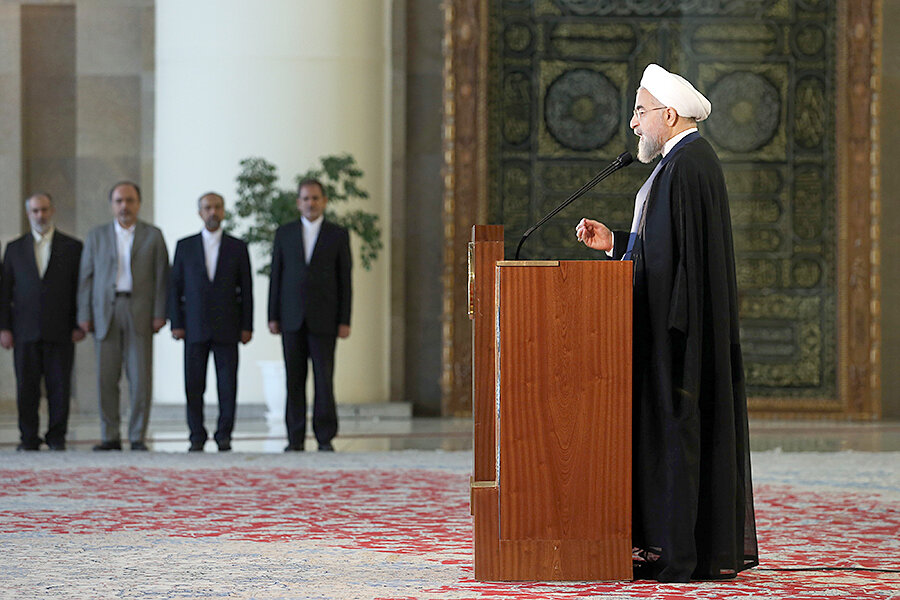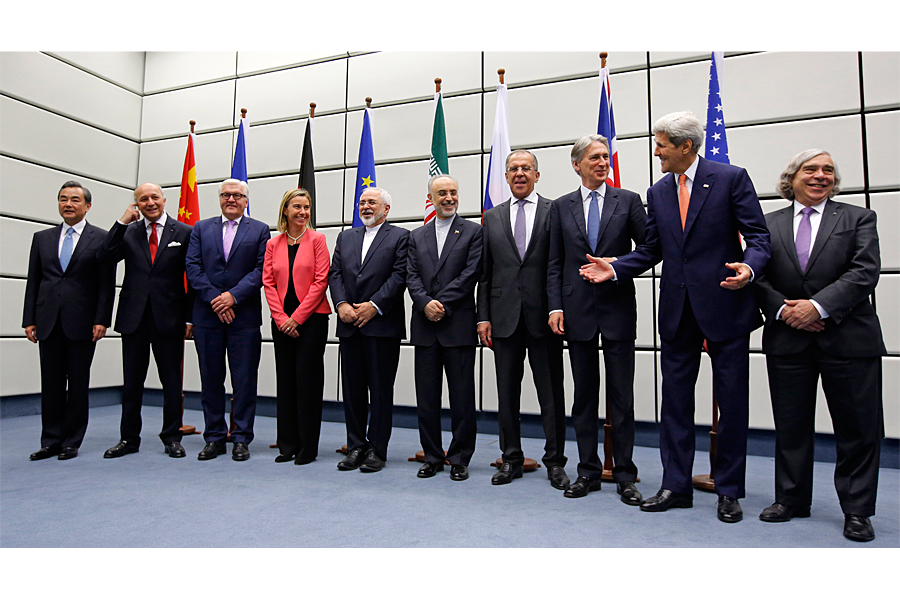Historic nuclear deal reached in Vienna: What does it mean for Iran?
Loading...
| Tehran, Iran
Iran and six world powers led by the United States have reached a historic agreement, a victory of diplomacy over war that verifiably limits Iran’s nuclear program in exchange for the lifting of sanctions.
Hailed by negotiators as striking a “win-win” balance, amid significant compromises by both sides, the complex and detailed agreement – running to 159 pages, with annexes – caps a 13-year dispute over Iran’s nuclear program that resulted in more than three years of talks, including the last 20 months of intensive negotiations in Switzerland and Austria.
The final – sometimes angry and emotional – 18-day push in the Austrian capital, Vienna, blew through four self-imposed deadlines before a deal was reached early Tuesday.
American officials say the agreement effectively cuts off four possible pathways to a nuclear weapon for more than a decade by strictly limiting Iran’s uranium enrichment capacity, stockpiles of nuclear material, and use of facilities, and by adding far more intrusive inspections.
Iranian officials say the deal will prove that Iran has no desire for nuclear weapons, and that it can pave the way for cooperation on other issues afflicting the Middle East.
“Today could have been the end of hope on this issue, but now we are starting a new chapter of hope, and let’s build on that,” said Iranian Foreign Minister Mohammad Javad Zarif. He said the deal was “not perfect for anybody,” but could “open new horizons for dealing with [other] serious problems.”
The deal is a “new chapter” and shows that diplomacy can “overcome decades of tensions and confrontations,” said Federica Mogherini, the European foreign policy chief who has led the talks on behalf of the so-called P5+1 group – the five permanent members of the UN Security Council (the US, Russia, China, Britain, and France) and Germany.
"With courage, political will and mutual respect, we delivered what the world was hoping for," said Ms. Mogherini. "A shared commitment to peace, and to join hands in order to make our world safer."
Which direction for Iran?
The deal, which follows a diplomatic process often overshadowed by the risk of war, is bound to have a profound effect on Iran, and raises the question of how the Islamic Republic’s regional role might change, if at all.
Will the Islamic Republic be empowered by a $100 billion post-sanctions windfall, as some of its rivals have warned, to exert more influence in the region via proxy armed forces that threaten Israel, Saudi Arabia, or other US allies?
Or will Iran – which faces regional challenges such as the Islamic State (IS) jihadists, sectarian strife, and the conflicts engulfing Syria, Iraq, and Yemen – look for areas of overlapping interests with the US and focus instead on its crippled economy?
The short answer, say analysts who know Iran, is the pocketbook: Tehran’s top priority will be resuscitating the economy as sanctions ease to improve the daily lives of 80 million Iranians and ensure stability at home. That issue helped elect President Hassan Rouhani in 2013.
“The mood is really for renewal rather than expansion, and to revive the economy and to keep the country going,” says Shahram Chubin, an Iran analyst with the Carnegie Endowment for International Peace in Geneva.
“I don’t think [the nuclear deal] will empower them to think that now they can run riot in the region at all,” he says. “After all the neglect that happened these last few years, they really have a lot of catching up to do, for the quality of life for their own people.”
For decades, Iran has opposed the US-dominated regional order and challenged Israel and US allies in the Gulf like Saudi Arabia, notes Mr. Chubin.
“Now … the ‘regional order’ has collapsed; nobody’s in charge of it,” and in some places like Iraq and Afghanistan, the interests of Iran and America overlap for the first time, he says. The result is the nuclear deal isn’t the end, rather “it’s the beginning of a process.”
Indeed, both President Barack Obama and Iran’s supreme leader, Ayatollah Ali Khamenei, have hinted that a successful nuclear deal could be the basis of future negotiations.
Moreover, resolving the once-intractable nuclear issue is an example of what may be possible, say Iran analysts, with other hard-to-crack problems like Syria, where Iran’s policies and interventions are diametrically opposed to Western ones.
So what are the key factors likely to shape Iran’s post-deal actions, at home and abroad?
Domestic expectations in Iran
Despite warnings from some US and Israeli politicians that Iran would use the freed-up revenues from the deal to spread “regional mischief,” the talk inside Iran focuses on easing economic pain.
“Those who say sanctions are not important don’t know what is happening in people’s pockets,” Mr. Rouhani said at a provincial rally in late June. He promised that with the deal “we will enrich both uranium and the economy.”
Since Iran’s oil industry – the country’s main source of foreign currency – is still state-owned and revenue flows through the central bank, the Rouhani administration “will get first dibs, and they have [domestic] priorities right now,” says Kevan Harris, of the Center for Iran and Persian Gulf Studies at Princeton University.
Iranians have been stung by soaring inflation in recent years, raising the cost of everything from tomatoes to medicine. So Iranian politicians have been talking up the economic benefit of sanctions removal, from foreign investments to more employment.
In April, lawmaker Ahmad Tavakkoli said Iran’s human resources, diverse climate, and geopolitical situation “have not been effectively used,” and that “concentrating on foreign issues would waste such opportunities and keep us away from reality.”
Estimates of Iran’s spending needs are vast, according to data compiled by Bijan Khajehpour, head of the Vienna-based arm of the Iran analytical firm, Atieh International. Rouhani’s top priority is the “empowerment of domestic industry,” including for export, and creating more value in the energy sector – all of which make jobs, he said in a presentation June 29.
But the initial pricetag will be $122 billion, with the banking sector alone requiring $25 billion to partly settle the previous government’s debts, estimates Mr. Khajehpour. Construction contracts, with their multiplier effects on jobs and the economy, will require a minimum of $30 billion, and the petroleum industry will need an interim $40 billion – just over half of the $70 billion necessary to bring oil production levels back to 2012 levels. Another $7 billion will be required for infrastructure projects from the Internet to telecoms.
Lifting sanctions will “be surely felt in people’s lives long-term,” said MP Abouzar Nadimi, deputy chair of parliament’s Economic Commission, in April. The nuclear deal will lead industry “to fulfill its full capacity."
Regional aspirations: Hegemony?
The nuclear deal was achieved even as the Middle East lurches into its most volatile period in decades.
While some Iranian officials hold fast to the rhetoric of “resistance” against US and Israeli influence – claiming that the ideals of Iran’s 1979 Islamic revolution are spreading – others recognize that Iran and the US are on the same side when it comes to fighting Sunni militants.
But will this deal enable a more antagonistic Iranian posture? Israeli Prime Minister Benjamin Netanyahu – who tried to block it – said in March that Iran was “gobbling up four countries right now,” and would control more if sanctions were lifted.
And Martin Indyk, a former senior US official now at the Brookings Institution, testified to the Senate in early June that a new regional security network must “contain and roll-back Iran’s nefarious hegemonic ambitions.”
But as painful as they have been for Iran’s economy, the sanctions have hardly been a deterrent to its military endeavors: Iran has still rearmed Lebanese Hezbollah with tens of thousands of rockets for any future battle with Israel; spent billions of dollars a year backing Syria’s President Bashar al-Assad in a war that has taken more than 220,000 lives; and resurrected Shiite militias in Iraq to fight IS – ironically in concert with US airstrikes.
“I don’t think the release of funds, which after all is going to be very gradual, is going to change the pace or intensity of any of [Iran’s] significant involvements,” says Richard Dalton, a former British ambassador to Iran now at the Chatham House think tank in London.
“It’s all very opaque, so we don’t know whether there’s updating of a Hezbollah capability, or they have a wish list from Assad that they’ve been gagging to respond to and haven’t been able to,” he says. “There could be. But ... these will be incremental.”
From Beirut to Kabul, Iran’s model now is defensive, says Carnegie’s Chubin. Syria, especially, has been costly in cash and dead Iranian generals, and also has tarnished Hezbollah. “Iran is not madcap about doing more,” he says.
Seeking to engage Iran
The narrative that Iran will “plow its hard-won sanctions relief into regional adventurism … is powerful, compelling, and frightening. It is also not true,” wrote Richard Nephew, a former director for Iran at the US National Security Council and former member of the US nuclear negotiating team, in a mid-June column for Reuters.
Such analysis defies history, he argued, because when Iran had $100 billion in restricted oil funds just over two years ago, it “was not plowing it all into Assad, the Houthis [in Yemen] or troublemaking along the Gulf.” When Iran was making $88 billion a year from high oil prices in 2012, he wrote, “no one alleges that all of that money was going to terrorists.”
With the nuclear deal done, the European Council on Foreign Relations is proposing engagement with Iran. In a report this week, the London-based think tank calls for “high-level and high-intensity” talks similar to the nuclear negotiations, to focus on “de-escalation and conflict resolution.”
Princeton’s Mr. Harris argues for just such an approach.
“The places where Iran has influence tend to be the places where the region has collapsed,” he says. “If one truly believes that Iran is on the march, then the best way to block it is to come up with a regionally-agreed-upon pathway to a more stable Middle East.”
Abiding US-Iran distrust
Despite the nuclear deal triumph and unprecedented face time between top diplomats, US-Iran détente is not around the corner.
The US last month declared that “Iran’s state sponsorship of terrorism worldwide remained undiminished” in 2014. And in Iran, hardliners still chant “Death to America,” even in parliament.
Throughout the nuclear talks, Khamenei often described his mistrust of the US, and listed the reasons why. If before the deal that level of suspicion scored 100, now Khamenei’s “inherent distrust of the US is going to stay at 85 or 90,” says Dalton of Chatham House.
He expects ad hoc US-Iran consultations on overlapping interests “to move things forward incrementally,” but no pro-Iran tilt in Washington that disadvantages either Israel or America’s Gulf allies. At least both the US and Iran now can “pick up the phone and know who to talk to.”
“Diplomatic communication is going to be more effective,” says Dalton. “But whether [it] will be more influential? That is a completely different question.”







